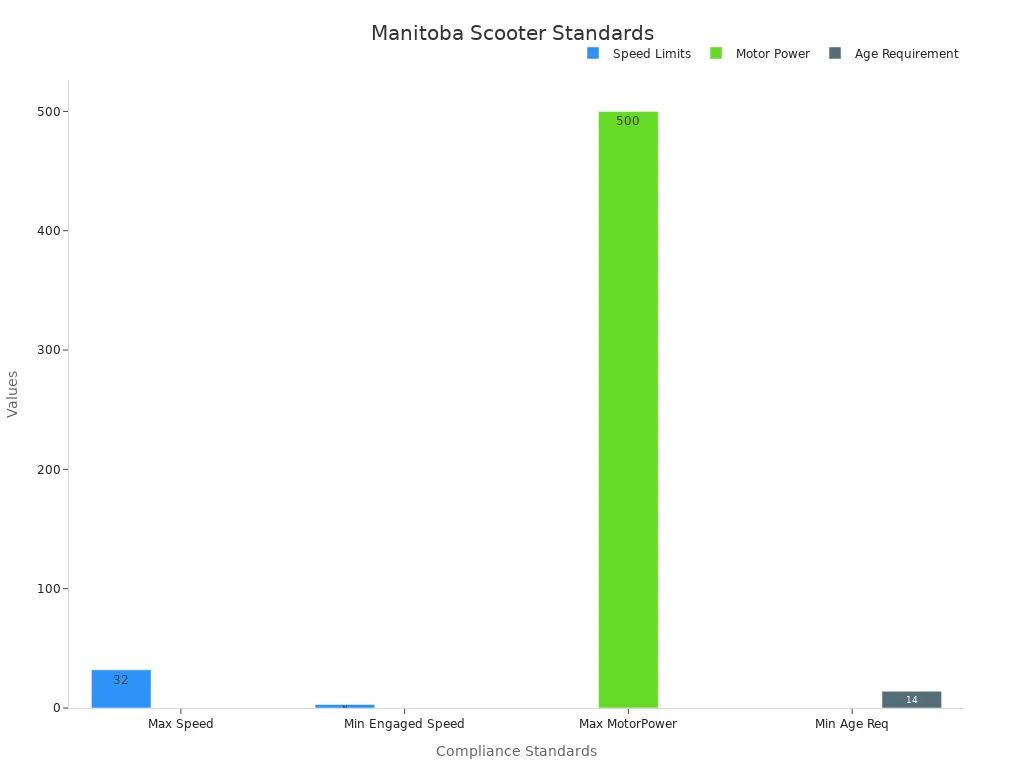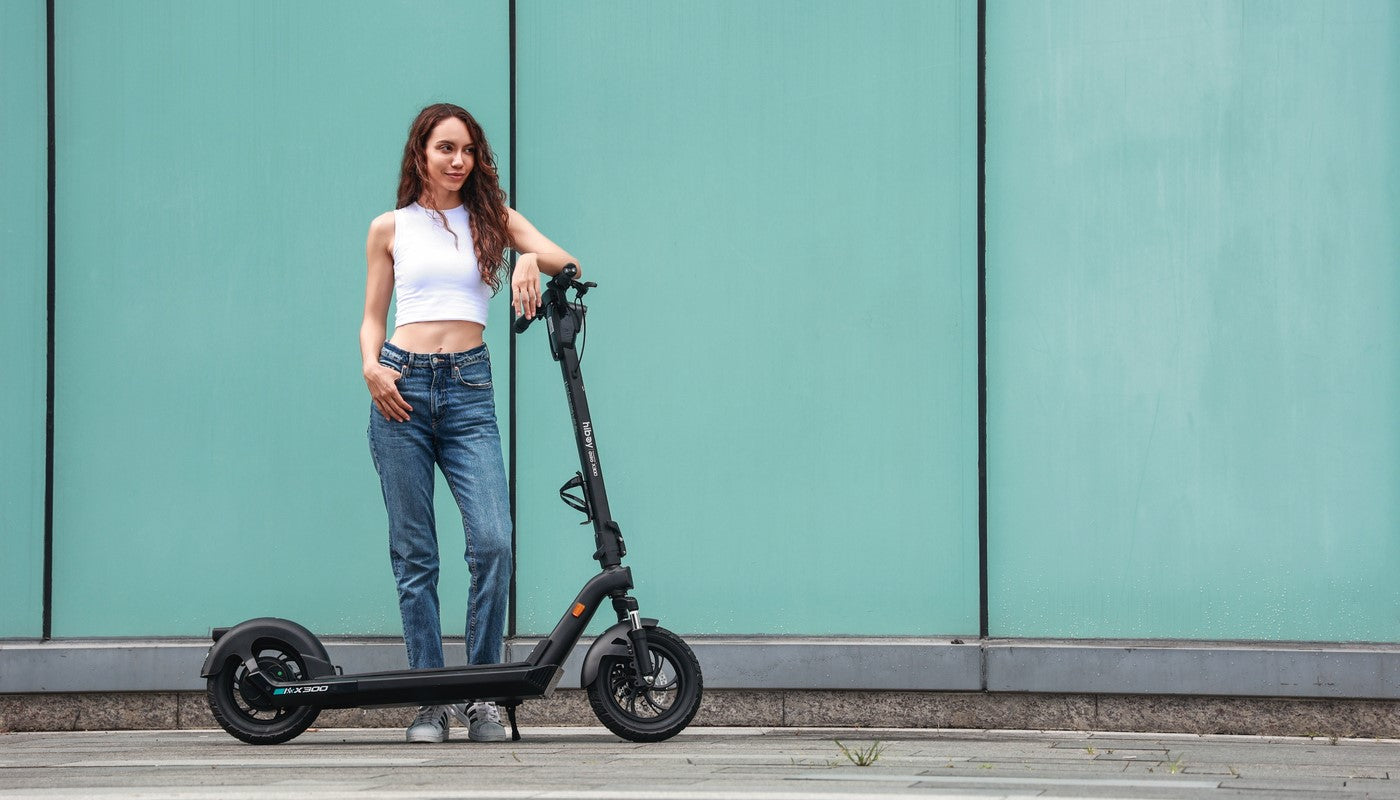Electric scooters are gaining popularity across Canada, but their growing use comes with legal responsibilities, particularly regarding Electric Scooter Laws. Understanding the legal status of electric scooters is critical for safe and lawful riding. By 2025, the eScooter and motorcycle market is expected to reach $13,864.0 million, reflecting this sector's rapid expansion. However, with this rise comes an increase in injuries. A study revealed 523 motorized scooter-related incidents in Canada over seven years, highlighting the need for awareness of safety rules. Electric scooter riders must familiarize themselves with Electric Scooter Laws to avoid fines and ensure a safe experience for everyone.
Key Takeaways
-
Learn the age rules for riding electric scooters nearby. Most places say riders must be at least 16 years old.
-
Always wear a helmet when using an electric scooter. Helmets help protect your head from serious injuries.
-
Check local rules for speed limits and riding spots. Most areas limit speeds to 20-25 km/h and ban sidewalk riding.
-
Know if you need insurance or registration for your scooter. Most places don’t require insurance for personal use, but check to be sure.
-
Understand local laws to avoid getting fined. Knowing the rules keeps riding safe and fun.
National Regulations for Electric Scooters

Minimum Age Requirements
Age restrictions for electric kick scooters are a critical part of e-scooter regulations in Canada. You must meet the minimum age requirement to legally operate an electric kick scooter. Many rental companies set this limit at 18 years, ensuring riders have the maturity to handle these vehicles responsibly. Despite these rules, injuries among children and adolescents remain a concern. This highlights the importance of parental supervision and adherence to local regulations.
Urban areas have seen a surge in electric kick scooter use, prompting authorities to implement pilot programs to test shared e-scooter schemes. These programs often include age restrictions to prioritize safety. As a rider, you should always verify the age requirements in your province or city before hopping on an electric kick scooter.
Helmet Laws
Helmet laws play a vital role in reducing injuries among electric scooter users. In Canada, wearing a helmet is mandatory in most provinces when riding an electric kick scooter. This simple safety measure can significantly lower the risk of head injuries. Studies show that enforcing helmet laws leads to fewer accidents and less severe injuries.
|
Helmet Law Benefits |
Impact |
|---|---|
|
Increased helmet use |
Reduced injury severity |
|
Enforced helmet laws |
Fewer eScooter-related injuries |
|
Safety education |
Improved rider awareness |
You should always wear a helmet that meets safety standards, even if local regulations don't require it. This proactive approach ensures your safety and sets a good example for others.
Speed Limits and Power Restrictions
Speed limits and power restrictions are essential components of electric scooter laws. In Canada, most provinces cap the maximum speed of electric kick scooters at 20-25 km/h. These limits reduce the risk of accidents and make scooters safer for riders and pedestrians. Additionally, power restrictions ensure that electric kick scooters remain lightweight and manageable.
Local governments are exploring sustainable transport solutions, including regulations favoring e-scooters. These measures address traffic congestion and pollution in urban areas. You should always check the speed and power limits for your electric kick scooter to stay compliant with local regulations.
The growing popularity of electric kick scooters reflects the need for clear and effective e-scooter regulations. By following these national guidelines, you can enjoy a safe and responsible riding experience.
Where Electric Scooters Are Allowed to Operate
Knowing where you can legally ride electric kick scooters is essential for staying compliant with electric scooter laws in Canada. Each province and city has its own rules, but there are some general guidelines you can follow.
-
Sidewalks: In most areas, riding on sidewalks is prohibited. This rule ensures pedestrian safety and reduces the risk of collisions. Always check your local regulations to confirm whether sidewalks are off-limits.
-
Bike Lanes: Many provinces allow electric kick scooters in bike lanes. These lanes provide a safer space for riders, away from cars and pedestrians.
-
Roadways: Some cities permit scooters on roads with speed limits under 50 km/h. This restriction minimizes the risk of accidents with faster-moving vehicles.
-
Parks and Trails: Certain parks and recreational trails allow electric kick scooters, but only if they meet specific speed and power limits. Always look for posted signs before entering these areas.
Tip: If you're unsure about where to ride, check if your city has a pilot program for electric scooters. These programs often include detailed maps of permitted zones.
Riding in unauthorized areas can result in fines or penalties. To avoid this, familiarize yourself with the rules in your city or province. Staying informed helps you enjoy a hassle-free riding experience.
Insurance and Registration Requirements
Understanding the insurance and registration requirements for electric kick scooters is just as important as knowing where to ride them. These rules vary across Canada, so you need to check your local regulations.
-
Insurance: Most provinces do not require insurance for electric kick scooters used for personal purposes. However, if you use a scooter for commercial activities, such as deliveries, you may need liability insurance. This protects you in case of accidents or property damage.
-
Registration: In many areas, electric kick scooters do not require registration. This is because they are classified as low-speed vehicles. However, some provinces may require a special permit or license for scooters exceeding certain speed or power limits.
|
Province |
Insurance Required? |
Registration Required? |
|---|---|---|
|
Ontario |
No |
No |
|
British Columbia |
Yes (for commercial use) |
No |
|
Quebec |
No |
Yes (for high-power models) |
Note: Always carry proof of insurance if it is required in your area. This ensures you can provide documentation if stopped by authorities.
Failing to meet insurance or registration requirements can lead to fines or even confiscation of your scooter. By staying compliant, you protect yourself and others on the road.
Provincial Regulations
Ontario
Ontario has taken a proactive approach to regulating electric kick scooters. The province launched a five-year pilot program in 2020 to test their integration into urban transportation. By 2025, this program has shaped many of the rules you must follow. Riders must be at least 16 years old to operate an electric kick scooter in Ontario. Helmets are mandatory for those under 18, though wearing one is strongly recommended for all riders.
You can ride electric kick scooters on roads with speed limits of 50 km/h or less, but sidewalks remain off-limits. Bike lanes are the preferred option for safer travel. The maximum speed for scooters is capped at 24 km/h, and the motor power cannot exceed 500 watts. Ontario does not require insurance or registration for personal use scooters, making it easier for you to get started. However, always check local bylaws, as cities like Toronto may have additional restrictions.
British Columbia
British Columbia has stricter rules for electric kick scooters compared to other provinces. The province requires riders to participate in its pilot program, which allows scooters only in select municipalities. You must be at least 16 years old to ride, and wearing a helmet is mandatory for all users.
Scooters in British Columbia must adhere to a maximum speed of 20 km/h and a motor power limit of 500 watts. You can ride in bike lanes and on designated pathways, but sidewalks are prohibited. Unlike Ontario, British Columbia requires insurance for commercial use scooters. This ensures liability coverage in case of accidents. Personal use scooters, however, do not need insurance or registration.
If you plan to ride in British Columbia, always verify whether your municipality is part of the pilot program. This will help you avoid fines and ensure you ride in permitted areas.
Quebec
Quebec has embraced electric kick scooters as part of its urban mobility strategy. The province has implemented clear rules to ensure safety and accessibility. Riders must be at least 18 years old, and helmets are mandatory for all users. Scooters must not exceed a speed of 25 km/h or a motor power of 500 watts.
You can ride electric kick scooters in bike lanes and on roads with speed limits under 50 km/h. Sidewalks are off-limits to protect pedestrians. Quebec also requires registration for high-power scooters, though personal use models typically do not need it. Insurance is not mandatory unless the scooter is used for commercial purposes.
Quebec's pilot program has been a significant success. Over 1,500 shared e-bikes were introduced in Montreal and Quebec City, with users completing more than 50,000 trips during the trial period. The average trip lasted about 25 minutes, highlighting the practicality of these vehicles for short commutes. This data underscores the growing popularity of electric kick scooters in Canada and the importance of adhering to local regulations.
Tip: Always check for updates to Quebec's laws, as pilot programs often lead to permanent changes in regulations.
Alberta
Alberta has embraced electric kick scooters as part of its transportation landscape. The province allows these scooters on roads and bike lanes, but sidewalks remain off-limits. Riders must be at least 16 years old to operate an electric kick scooter. Helmets are mandatory for riders under 18, though wearing one is recommended for everyone.
The maximum speed for electric kick scooters in Alberta is capped at 20 km/h. This limit ensures safety for both riders and pedestrians. The motor power must not exceed 500 watts, keeping the scooters lightweight and manageable. You can ride on roads with speed limits of 50 km/h or less, but always check local bylaws for additional restrictions.
Alberta does not require insurance or registration for personal use scooters. However, if you use a scooter for commercial purposes, liability insurance may be necessary. This protects you in case of accidents or property damage.
The province has also implemented a pilot program to test the integration of electric kick scooters into urban areas. This program helps authorities evaluate safety and accessibility while promoting sustainable transportation. Always stay updated on local regulations to ensure compliance and enjoy a safe riding experience.
Manitoba
Manitoba has specific compliance standards for electric kick scooters. Riders must be at least 14 years old to operate these scooters. Helmets are mandatory for all users, regardless of age. The maximum speed is limited to 32 km/h, and the motor power cannot exceed 500 watts. Additionally, the motor engages only when the scooter reaches a minimum speed of 3 km/h.
|
Compliance Standard |
Value |
|---|---|
|
Maximum Speed |
32 km/h |
|
Maximum Motor Power |
500W |
|
Minimum Age Requirement |
14 years |
|
Minimum Speed for Motor Engagement |
3 km/h |
Manitoba allows electric kick scooters on bike lanes and roads with speed limits under 50 km/h. Sidewalks are prohibited to ensure pedestrian safety. The province does not require insurance or registration for personal use scooters. However, you should always verify local rules before riding.

Manitoba's clear regulations make it easier for you to enjoy electric kick scooters while staying safe and compliant. Always wear a helmet and follow the rules to ensure a smooth riding experience.
Saskatchewan
Saskatchewan has adopted a cautious approach to electric kick scooters. The province allows these scooters on bike lanes and roads with speed limits under 50 km/h. Sidewalks are off-limits to protect pedestrians. Riders must be at least 16 years old, and helmets are mandatory for all users.
The maximum speed for electric kick scooters in Saskatchewan is 25 km/h, and the motor power cannot exceed 500 watts. These limits ensure that scooters remain safe and easy to control. The province does not require insurance or registration for personal use scooters. However, you should always check local bylaws for additional requirements.
Saskatchewan's rules aim to reduce accidents and promote safety. Data shows 163 emergency room visits related to electric kick scooters, with one fatal crash reported. Helmet usage remains low at 44%, highlighting the need for greater awareness.
|
Metric |
Value |
|---|---|
|
Emergency room visits |
163 |
|
Fatal e-scooter crashes |
1 |
|
Helmet usage (percentage) |
44% |
By following Saskatchewan's regulations, you can help reduce accidents and ensure a safer environment for everyone. Always wear a helmet and stay informed about local rules to enjoy a hassle-free ride.
Nova Scotia
Nova Scotia has established clear rules for electric scooters to ensure safety and accessibility. If you plan to ride an e-scooter in this province, you must follow these regulations to avoid penalties and enjoy a smooth experience.
The minimum age for riding electric scooters in Nova Scotia is 16 years. This age requirement ensures that riders have the maturity to operate these vehicles responsibly. Speed limits are set at either 20 km/h or 25 km/h, depending on the area. These limits help reduce accidents and make scooters safer for both riders and pedestrians.
You can only ride e-scooters in bike lanes. This restriction keeps sidewalks safe for pedestrians and minimizes conflicts with motor vehicles. Nova Scotia’s focus on bike lane usage reflects its commitment to integrating scooters into urban transportation while prioritizing safety.
Tip: Always check for local signage or maps to confirm bike lane locations before riding. This helps you stay compliant and avoid fines.
Nova Scotia’s regulations align with Canada’s broader efforts to promote sustainable transportation. By following these rules, you contribute to safer streets and a cleaner environment.
City-Specific Rules
Toronto
Toronto has implemented strict rules for electric scooters to ensure safety and accessibility. You cannot ride e-scooters on sidewalks, as this protects pedestrians from potential accidents. Instead, you must use bike lanes or roads with speed limits under 50 km/h. The city also enforces a maximum speed limit of 24 km/h for e-scooters.
Parking compliance remains a challenge in Toronto. Only 60% of e-scooters are parked in designated areas, compared to a 97% compliance rate in other jurisdictions. This discrepancy highlights the need for better rider education and enforcement. Additionally, 56% of disabled individuals report barriers caused by improperly parked scooters, emphasizing the importance of responsible parking.
|
Evidence Type |
Statistic/Fact |
Source |
|---|---|---|
|
Compliance Rate |
60% of e-scooters parked correctly in designated areas. |
City Data |
|
Compliance Rate (Other Areas) |
97% compliance in other jurisdictions. |
City Data |
|
Barriers for Disabled People |
56% face barriers due to public space features. |
Statistics Canada |
To stay compliant, always park your scooter in designated zones and avoid blocking pathways. Following these rules ensures a safer and more accessible city for everyone.
Vancouver
Vancouver’s electric scooter regulations focus on safety and sustainability. You can ride e-scooters in bike lanes and on roads with speed limits under 30 km/h. Sidewalk riding is prohibited to protect pedestrians. The city also requires helmets for all riders, regardless of age.
Vancouver participates in a pilot program to test e-scooter integration. This program evaluates their impact on traffic and safety. You must adhere to a maximum speed of 20 km/h and a motor power limit of 500 watts. These restrictions ensure that scooters remain manageable and safe for urban use.
The city’s emphasis on bike lane usage reflects its commitment to reducing traffic congestion and promoting eco-friendly transportation. Always check for updates to local regulations, as pilot programs often lead to permanent changes.
Montreal
Montreal enforces strict rules for electric scooters to maintain order and safety. You can only ride e-scooters in bike lanes or on roads with speed limits under 50 km/h. Sidewalk riding is strictly prohibited. Helmets are mandatory for all riders, ensuring protection in case of accidents.
The city has also banned shared e-scooter programs in certain areas due to safety concerns. This decision has led to a 9-11% increase in urban travel time during recurring evening trips. Large events have seen a 37% rise in travel time, highlighting the impact of these bans.
|
Impact of Electric Scooter Bans |
Increase in Urban Travel Time |
|---|---|
|
Recurring Evening Trips |
9-11% |
|
Large Events |
37% |
Montreal’s regulations aim to balance safety with urban mobility. Always follow the rules to avoid fines and contribute to a safer environment for all road users.
Calgary
Calgary has established clear rules for electric scooter use to ensure safety and accessibility. You can ride e-scooters on bicycle lanes, pathways, and roads with lower traffic volumes. Busier roadways, such as Macleod Trail, are off-limits. These restrictions help reduce accidents and protect riders from high-speed vehicles.
E-scooters in Calgary must follow the same rules as bicycles. This means you need to obey traffic signals, yield to pedestrians, and avoid riding on sidewalks. These guidelines create a safer environment for everyone sharing public spaces.
The city’s approach to regulating e-scooters has proven effective. Data shows 1,272 emergency department visits related to e-scooter incidents. Transportation-related injuries account for 15% of these visits. Despite this, the incident rate remains low, with only one injury per 1,400 trips.
|
Metric |
Value |
|---|---|
|
Total emergency department visits |
1,272 |
|
Percentage of transportation-related injuries |
15% |
|
Incident rate per ride |
1 injury per 1,400 trips |
Tip: Always wear a helmet and follow local traffic laws to minimize risks. These simple precautions can make your rides safer and more enjoyable.
Calgary’s rules aim to balance convenience with safety. By adhering to these regulations, you contribute to a safer urban environment while enjoying the benefits of electric scooters.
Edmonton
Edmonton has taken significant steps to regulate electric scooters and ensure rider safety. The city has implemented measures to address common concerns like unsafe road use and improper parking. These efforts aim to create a safer and more organized environment for everyone.
To manage the growing popularity of e-scooters, Edmonton introduced a competitive procurement process for service providers. This process limits the number of approved providers to two. Each provider can operate a maximum fleet of 750 e-scooters. This restriction reflects the preferences of Edmontonians and helps prevent overcrowding on streets and pathways.
E-scooter companies in Edmonton must also meet strict requirements. They need to propose effective solutions for unsafe riding behaviors and parking issues. Additionally, they are required to educate riders about safe practices. These initiatives promote responsible usage and reduce the risk of accidents.
You can ride e-scooters in bike lanes and on roads with speed limits under 50 km/h. Sidewalk riding is prohibited to protect pedestrians. Helmets are strongly recommended, even though they are not mandatory for adults. Following these rules ensures a safer experience for both riders and others sharing public spaces.
Tip: Always park your e-scooter in designated areas to avoid fines and contribute to a more accessible city.
Edmonton’s approach to e-scooter regulation balances convenience with safety. By following the city’s rules and guidelines, you can enjoy a smooth and responsible riding experience.
How to Stay Compliant and Ride Safely

Tips for Understanding Local Laws
Understanding local regulations is essential for riding electric scooters safely and legally. Each city and province may have unique rules, so you should always check the specific requirements in your area. For example, some cities prohibit riding on sidewalks, while others allow it in designated zones. Knowing these details helps you avoid fines and ensures a safer experience for everyone.
Many cities have introduced pilot programs to test electric scooter integration. These programs often include maps and guidelines that outline where you can ride. Take advantage of these resources to stay informed. Additionally, some areas require a license or permit for high-powered scooters. Always verify whether this applies to your vehicle before riding.
Tip: Bookmark your city’s transportation website or app for quick access to updated regulations. This ensures you stay compliant as rules evolve.
Recommended Safety Gear
Wearing the right safety gear can significantly reduce the risk of injuries. Helmets are the most important piece of equipment, as head injuries are common in electric scooter accidents. Choose a helmet that meets safety standards and fits snugly. Reflective clothing and lights enhance your visibility, especially when riding at night or in low-light conditions.
Gloves and knee pads provide additional protection in case of falls. These items are particularly useful for beginners who may need time to master balance and control. Always inspect your gear for wear and tear before each ride.
|
Safety Gear |
Purpose |
|---|---|
|
Helmet |
Protects against head injuries |
|
Reflective clothing |
Improves visibility |
|
Gloves and knee pads |
Reduces impact during falls |
Investing in quality safety gear is a small price to pay for your well-being.
Best Practices for Riding in Urban Areas
Riding in urban areas requires extra caution due to traffic and pedestrian activity. Always follow local traffic laws, such as speed limits and pedestrian right-of-way rules. Avoid riding on hazardous surfaces like wet pavement or gravel, as these can cause accidents.
Studies show that 20-30% of riders use sidewalks, which poses risks to pedestrians. Stick to bike lanes or designated pathways whenever possible. Over half of riders report near misses with other road users, highlighting the importance of staying alert.
Tip: Maintain a safe distance from vehicles and pedestrians to reduce the likelihood of collisions.
Urban riding also demands awareness of your surroundings. Use hand signals to communicate your intentions and make eye contact with drivers at intersections. These habits improve your safety and foster better interactions with other road users.
Resources for Staying Updated on Regulations
Staying informed about electric scooter laws ensures you ride safely and legally. Regulations can change frequently, especially as cities and provinces refine their rules. You need reliable resources to keep track of updates and avoid penalties.
1. Government Websites
Visit your city or province’s official transportation website. These sites often provide the latest information on electric scooter laws, including maps of permitted zones and pilot program updates. Bookmark these pages for quick access.
Tip: Look for sections labeled "Active Transportation" or "E-Scooter Guidelines" to find relevant details quickly.
2. Mobile Apps
Many cities offer transportation apps that include e-scooter regulations. These apps often feature interactive maps showing where you can ride legally. Some even send notifications about changes to local regulations. Downloading these apps can save you time and keep you compliant.
3. Community Forums and Social Media
Join local online communities or follow city transportation departments on social media. These platforms often share updates, answer questions, and provide tips for safe riding. Engaging with other riders can also help you learn about common mistakes to avoid.
4. E-Scooter Rental Companies
Rental companies like Lime or Bird often provide detailed guidelines for riders. Check their websites or apps for information on speed limits, helmet requirements, and permitted riding areas. These companies usually update their rules to align with local regulations.
5. News Outlets
Local news outlets frequently report on changes to transportation laws. Keep an eye on articles or broadcasts discussing electric scooters. These sources can alert you to new rules or pilot program expansions.
Note: Staying updated helps you avoid fines and ensures a safer riding experience for everyone.
Understanding electric scooter laws ensures you ride safely and legally. These laws vary across provinces and cities, reflecting the evolving nature of regulations. Staying informed helps you avoid fines or confiscation of your scooter.
|
Key Point |
Evidence |
|---|---|
|
Evolving Laws |
Electric scooter laws in Canada are constantly changing across different provinces and cities. |
|
Importance of Awareness |
Staying informed is crucial to avoid fines or confiscation of scooters. |
Always check local regulations before riding. This simple step ensures compliance and promotes a safer environment for everyone.
FAQ
What is the minimum age to ride an electric scooter in Canada?
The minimum age varies by province. For example, Ontario requires riders to be at least 16 years old, while Manitoba allows riders as young as 14. Always check your province’s specific regulations to ensure compliance.
Do I need insurance for my electric scooter?
Most provinces do not require insurance for personal use scooters. However, if you use your scooter for commercial purposes, liability insurance may be mandatory. Verify your local rules to avoid penalties.
Can I ride an electric scooter on sidewalks?
Sidewalk riding is prohibited in most provinces to protect pedestrians. You should use bike lanes or roads with lower speed limits. Check local signage or maps to confirm permitted zones before riding.
Are helmets mandatory for electric scooter riders?
Helmet laws depend on your province. In British Columbia and Quebec, helmets are mandatory for all riders. In Ontario, helmets are required for riders under 18. Wearing one is always recommended for safety.
What happens if I break electric scooter laws?
Violating regulations can result in fines, confiscation of your scooter, or even legal action. Always follow local rules to avoid penalties and ensure a safe riding experience.











Share:
26-Inch Bikes: Who Are They Best For?
Are 750-Watt Electric Bikes Legal in Canada?